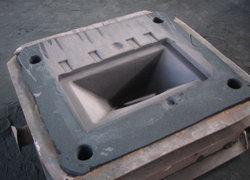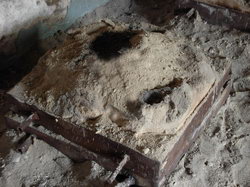| |
Foundry Sand Types
According to the different binders, foundry sand used for moulding
can be divided into green sand, water glass sand and resin sand.
Green Sand (Clay Sand)
Clay sand is the mixture of natural silica sand, clay, additives and
water. The clay used to make wet clay sand is bentonite clay. The
compressive strength is generally 0.05 to 0.1 Mpa. The water content
is 3.5 to 5%, and air permeability is more than 80. It is commonly
used in machine molding and hand
molding.
The sand made can be used to pour liquid metal without drying, which
has the advantages of low production cost and short production
cycle. Wet clay sand used in sand
casting production accounts for about 60%. As the wet sand
has a high moisture content, low strength and air permeability, the
castings can easily have the porosity, coarse, sticky sand and sand
expansion defects. In hand molding, the dimensional accuracy is low,
so it is generally used only for the production of small and medium
sized iron castings and non-ferrous alloy castings; while in
mechanical modeling, the castings have high dimensional accuracy, so
it is widely used for high-volume production of castings.
The clay used to make dry sand clay is ordinary clay, and its
moisture content is high. The sand made should be dried in the
temperature of about 250 ~ 400 ℃ and then be combined cast, and it
is generally used for steel
castings. Because of the high energy consumption, long
production cycle, low dimensional accuracy, dry sand is gradually
phased out.
Water Glass Sand (Sodium Silicate Sand)
Sodium silicate sand is a kind of foundry sand made by sodium
silicate (aqueous solution of sodium silicate) as the binder. The
sodium silicate added accounts for 6% to 8% of the sand quality.
Water glass hardening is necessary before pouring to improve
strength. The hardening methods are: chemical hardening with CO2 gas
and drying the heating surface. You can also put the hardening agent
in the sand, and then it will harden by itself. By eliminating or
greatly reducing the drying process, the emergence of sodium
silicate sand simplified greatly the sand molding process.
However, because its collapsibility is poor and falling sand, sand
cleaning and the sand recycling are very difficult, in
iron casting, the sand
sticks seriously, so it is not suitable for iron casting, but mainly
used in steel casting production.
Resin Sand (Phenolic, Furan)
Resin sand is a kind of
foundry sand with synthetic resin (phenolic resin and furan resin,
etc.) as the binder. The resin added is about 3% to 6% of the sand
quality. Resin sand can harden fast when heated 1 to 2 minutes, and
its dry strength is high, so the castings made are accurate in size,
the surface is smooth, and the collapsibility is excellent.
Since it has quick-drying and self-hardening characteristics, the
modeling process is easier to become mechanization and automation.
Resin sand is a promising new type of modeling material, and at
present, it is mainly used in the manufacture of complex sand cores.
Since different sands have different advantages, in metal casting,
we should adopt the right one to meet different needs.

Clay Sand, Green Sand

Furan Resin Sand

Dry Sand, Water Glass Sand
Home |
More Articles |
|
|
Main Casting Products
Stove Burner
Cast Iron Plate
Manhole Cover Casting
Brake Drum
Warping Head Casting
Ductile Iron Belt Pulley
Cast Iron Flywheel
Boiler Ash Door
Cast Iron Stove Grate
Tractor Gearbox
Pump Body
Cast Iron Brackets
Cast Iron Weight
Gear Casting
Large Cast Steel Bracket
Cast Iron Drainage Pipe
Flange Castings
Cast Iron Pipe Fittings
Burner Grates for Gas Stove
Grey Iron Counter Weight
Cast Iron Axle Support
Cast Iron Blocks
Gas Burner
Cast Iron Truck Castings
Cast Iron Tractor Parts
Cast Iron Stove Parts
Pump Shell and Valve Body
Cast Iron Umbrella Base
Cast Iron Pan,
Cookware
Boiler Soot
Collector
Butterfly Valve
Body |
